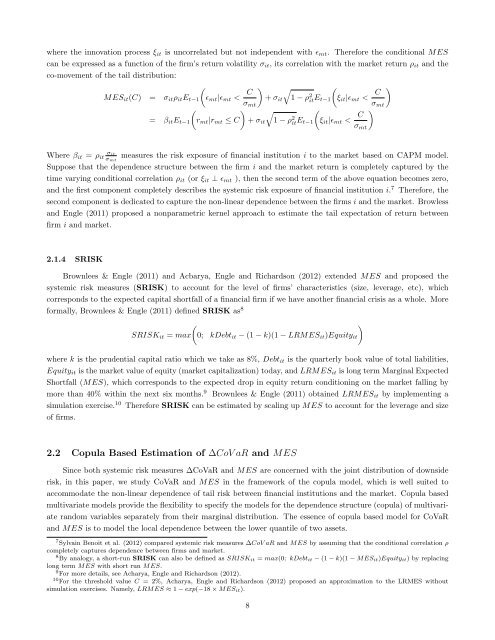Does Tail Dependence Make A Difference In the ... - Boston College
Does Tail Dependence Make A Difference In the ... - Boston College
Does Tail Dependence Make A Difference In the ... - Boston College
Create successful ePaper yourself
Turn your PDF publications into a flip-book with our unique Google optimized e-Paper software.
where <strong>the</strong> innovation process ξ it is uncorrelated but not independent with ɛ mt . Therefore <strong>the</strong> conditional MES<br />
can be expressed as a function of <strong>the</strong> firm’s return volatility σ it , its correlation with <strong>the</strong> market return ρ it and <strong>the</strong><br />
co-movement of <strong>the</strong> tail distribution:<br />
(<br />
MES it (C) = σ it ρ it E t−1 ɛ mt |ɛ mt <<br />
C )<br />
(<br />
+ σ it<br />
√1 − ρ 2 it<br />
σ E t−1 ξ it |ɛ mt <<br />
C )<br />
mt σ mt<br />
) √ (<br />
= β it E t−1<br />
(r mt |r mt ≤ C + σ it 1 − ρ 2 it E t−1 ξ it |ɛ mt <<br />
C )<br />
σ mt<br />
σ<br />
Where β it = ρ it it σ mt<br />
measures <strong>the</strong> risk exposure of financial institution i to <strong>the</strong> market based on CAPM model.<br />
Suppose that <strong>the</strong> dependence structure between <strong>the</strong> firm i and <strong>the</strong> market return is completely captured by <strong>the</strong><br />
time varying conditional correlation ρ it (or ξ it ⊥ ɛ mt ), <strong>the</strong>n <strong>the</strong> second term of <strong>the</strong> above equation becomes zero,<br />
and <strong>the</strong> first component completely describes <strong>the</strong> systemic risk exposure of financial institution i. 7 Therefore, <strong>the</strong><br />
second component is dedicated to capture <strong>the</strong> non-linear dependence between <strong>the</strong> firms i and <strong>the</strong> market. Browless<br />
and Engle (2011) proposed a nonparametric kernel approach to estimate <strong>the</strong> tail expectation of return between<br />
firm i and market.<br />
2.1.4 SRISK<br />
Brownlees & Engle (2011) and Acbarya, Engle and Richardson (2012) extended MES and proposed <strong>the</strong><br />
systemic risk measures (SRISK) to account for <strong>the</strong> level of firms’ characteristics (size, leverage, etc), which<br />
corresponds to <strong>the</strong> expected capital shortfall of a financial firm if we have ano<strong>the</strong>r financial crisis as a whole. More<br />
formally, Brownlees & Engle (2011) defined SRISK as 8<br />
)<br />
SRISK it = max<br />
(0; kDebt it − (1 − k)(1 − LRMES it )Equity it<br />
where k is <strong>the</strong> prudential capital ratio which we take as 8%, Debt it is <strong>the</strong> quarterly book value of total liabilities,<br />
Equity it is <strong>the</strong> market value of equity (market capitalization) today, and LRMES it is long term Marginal Expected<br />
Shortfall (MES), which corresponds to <strong>the</strong> expected drop in equity return conditioning on <strong>the</strong> market falling by<br />
more than 40% within <strong>the</strong> next six months. 9 Brownlees & Engle (2011) obtained LRMES it by implementing a<br />
simulation exercise. 10 Therefore SRISK can be estimated by scaling up MES to account for <strong>the</strong> leverage and size<br />
of firms.<br />
2.2 Copula Based Estimation of ∆CoV aR and MES<br />
Since both systemic risk measures ∆CoVaR and MES are concerned with <strong>the</strong> joint distribution of downside<br />
risk, in this paper, we study CoVaR and MES in <strong>the</strong> framework of <strong>the</strong> copula model, which is well suited to<br />
accommodate <strong>the</strong> non-linear dependence of tail risk between financial institutions and <strong>the</strong> market. Copula based<br />
multivariate models provide <strong>the</strong> flexibility to specify <strong>the</strong> models for <strong>the</strong> dependence structure (copula) of multivariate<br />
random variables separately from <strong>the</strong>ir marginal distribution. The essence of copula based model for CoVaR<br />
and MES is to model <strong>the</strong> local dependence between <strong>the</strong> lower quantile of two assets.<br />
7 Sylvain Benoit et al. (2012) compared systemic risk measures ∆CoV aR and MES by assuming that <strong>the</strong> conditional correlation ρ<br />
completely captures dependence between firms and market.<br />
8 By analogy, a short-run SRISK can also be defined as SRISK it = max(0; kDebt it − (1 − k)(1 − MES it )Equity it ) by replacing<br />
long term MES with short run MES.<br />
9 For more details, see Acharya, Engle and Richardson (2012).<br />
10 For <strong>the</strong> threshold value C = 2%, Acharya, Engle and Richardson (2012) proposed an approximation to <strong>the</strong> LRMES without<br />
simulation exercises. Namely, LRMES ≈ 1 − exp(−18 × MES it ).<br />
8
















